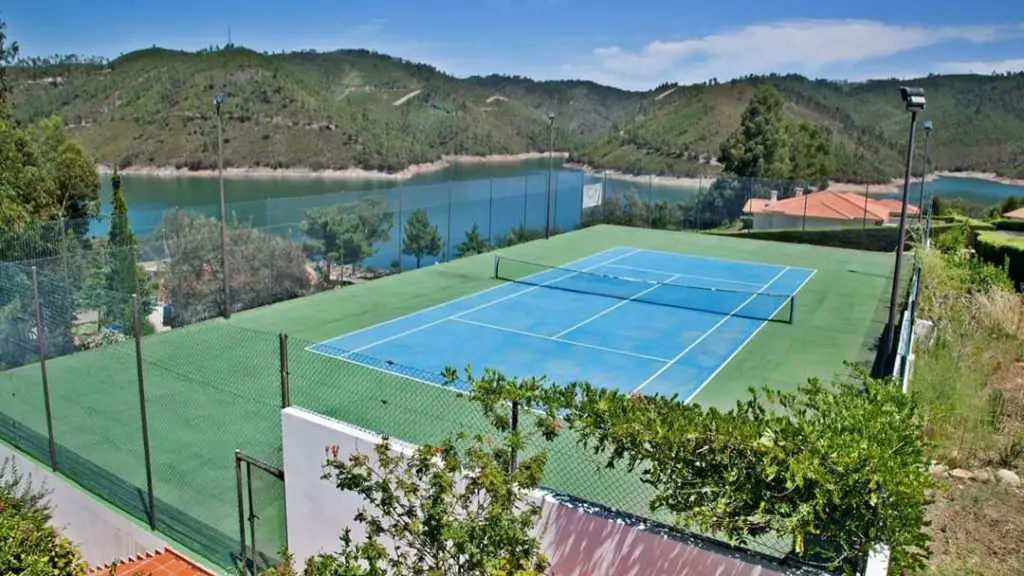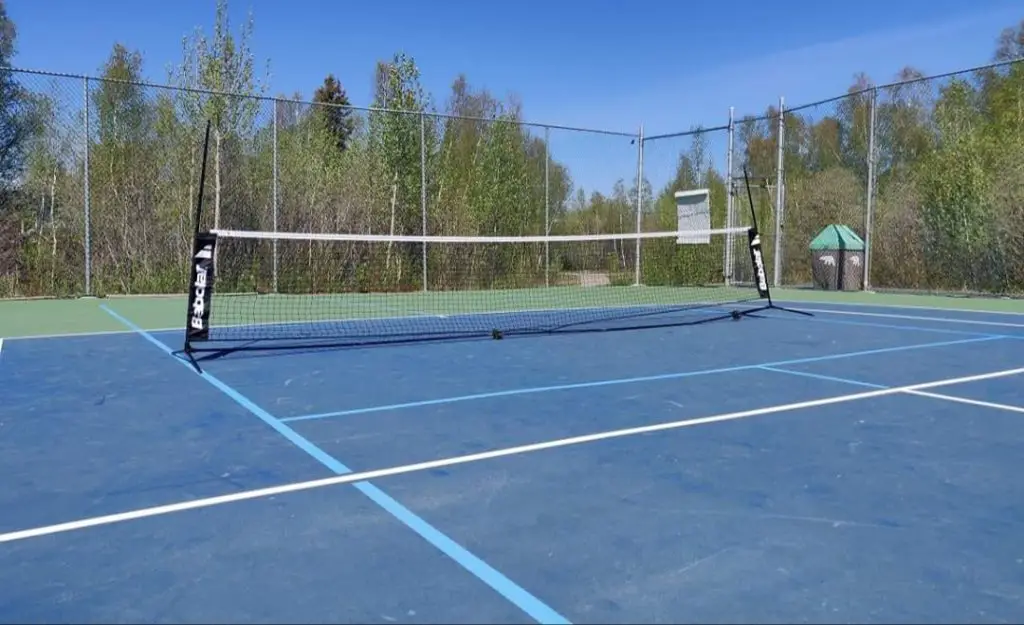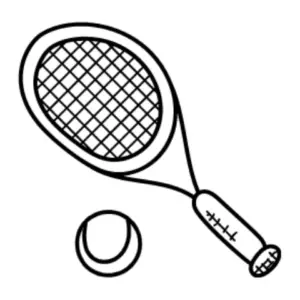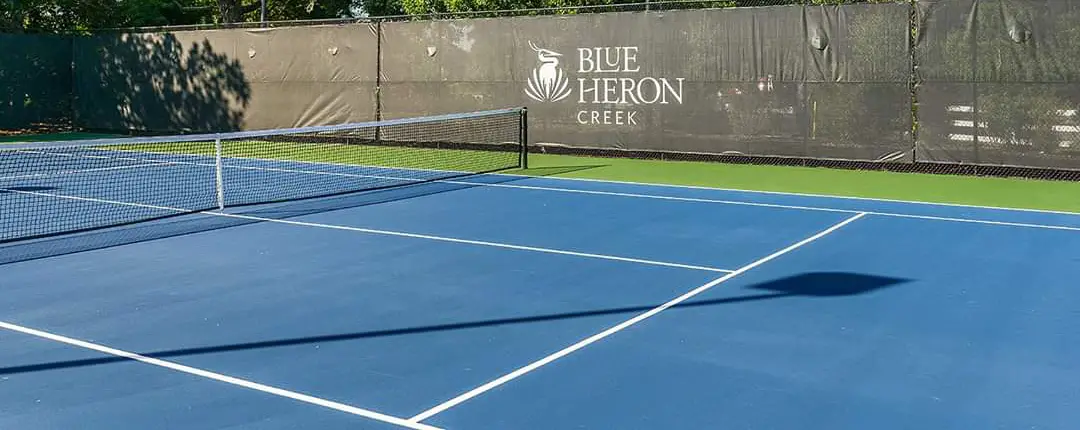If you have been wondering why tennis courts are blue then you surely are not the only one wondering this. Get this and many more answers on our site now.
It doesn’t matter where you decide to play tennis, one thing you’ll notice for sure is that most hard court colors is currently blue. It wasn’t really the case a few years ago, but ever since the U.S. Open switched in 2005 and the Australian Open switched in 2008, most tennis courts around the world start to follow the blue color trend.
There are lots of people who doesn’t see the blue color as anything, but a lot of people starts to wonder why tennis courts are blue. In this article, we will be explaining everything you need to know about tennis courts being blue.
Why are tennis courts blue? The reason for this is because the color blue gives off the right contrast with a standard tennis ball. And because of this it is much easier to see what is taking place not only for the players, but also for the spectators on television as well. Also, you should know that the U.S. Open and Australian Open are the main trendsetters behind the blue hard courts around the world. Once they thought blue was the right way to go, many other courts followed.
The Evolution of Tennis Court Colors

We all know that tennis played on natural surfaces like grass and clay cannot be changed which is why they stayed to their distinct color. Expect for rare circumstances, for example when the Madrid Open tinkered with blue clay, you should keep in mind that grass courts are green and red clay courts are red.
When hard court made of concrete or asphalt first came into play, most court designers decided that they would just stick to the green color which is very similar to green. They thought that if it worked so well for grass tournament, it would work just as good for hard courts as well.
Until the early 2000s, green court started to become the norm. Around the world, a lot of courts would either stick to the same color, or they would just experiment with the opposite color on the color wheel (red).
Tennis tournament organizers are very tentative when it comes to changing the colors, but with the tennis ball being a neon yellow-green, there are many organizers around the world that thought the ball would stand out more on television with a different surface color. That’s when blue and purple courts starts to make a wave in the world of tennis.
Making Tennis Spectator Friendly
In order for a sport to grow consistently if have to be spectator friendly since they are the ones showing support. The fact that a tennis ball is capable of traveling well over 100 miles per hour during a point, this can be quite challenging for the fans to see what’s taking place on the court with the moving so fast. So in order to make things a little easier for the fans, the tournament director started researching different colors and starts to play around with court designs.
If you should take a close look at any color wheel, what you’ll notice is that blue and purple are the opposite color across from the color of a tennis ball. This make it much easier for people in person and those who are watching on television to see what’s happening on the court much clearly. Better television quality has done a wonderful job in helping the sport, but the color change is said to be the most life changing decision.
At one point tennis started to face the same difficulties as hockey with the game translating to television. Following the ball movement is pretty hard and it’s almost impossible to see any real spin while watching the TV at home. The color of the ball, which was known to be white, had to change into a fluorescent yellow-green that stand out more on television. The blue court used make the ball pop out even more.
How US Open Blue Came to Life

Many people thought that the color change to blue had came to life by tennis officials using a color wheel and randomly pick a color that they like, well that’s not true. Tennis officials actually put a lot of time and effort into finding the best color for the tournament, which ends up benefiting everyone in the process.
There was a study that had been done by California Sports Services, it was to find the best color that would not only be appealing in person and on television, but a color that fall in the blue-purple spectrum that contrasts with the neon yellow-green tennis ball. After constantly running multiple tests, they settled on Pantone blue 2965 U. It’s well known today, officially, as US Open Blue.
Even though they have set the in-bound color, the U.S. Open wanted a different color for the outside lines. The reason for this is because they felt that it would provide a better visual for viewers, but for this the right color was needed.
After a few meetings, the California Sports Services once again settled on another color which was Pantone 357 U. The color was considered to be the darker shade of green which is known to be the U.S. Open Green. With that said, they are currently the only Grand Slam that you’ll see with two colors, which gives the U.S Open an appealing look. Because of this it’s also much easier to tell the difference between the four majors.
One thing for sure about is that the color changed has been rarely talked about since it has been in effect. There are many people who find it odd that it was ever a different color. The shade if green and blue literally stand out and making it way better for both in person and television viewers.
Branding
The biggest known hard court tournament of the year is considered to be the U.S Open, which usually take place in late August and early September. Before the big tournament there are several other tournaments in the United States that’s officially a part of the U.S Open series. What a lot of viewers will realize is that all the tennis court colors are all the same and this isn’t by mistake.
This is absolutely a smart move and it’s what we called branding. When casual players sees the color, they have an idea that it is part of the U.S Open series. It’s a precise change that the brain won’t be able to process straight away, but eventually the brain will pick up on the correlation and provides better overall brand recognition.
Since the blue color tennis court has become very popular around the globe, a lot of tennis courts starts to follow in the same footsteps as well. These days green and red courts are not very common and as you can see there are lots of schools and parks that are going with the blue color courts. The color might be slightly different in terms of the shade, but one thing for sure is that the change is noticeable.
Another thing is that the Australian Open isn’t up to date with the color scheme and their Grand Slam usually happens at the beginning of the year. Their blue color, which is a bit on the lighter side and actually fills the entire playing surface, is mostly popular in Australia and Asia. It hasn’t made it way around the rest of the world as yet.
What Can Be The Other Colors Used On A Court?
Though blue seems to be the colour most used for professional games, there are other colours that can be used for the game as well.
The colours can be segregated on the basis of a few criteria and we have listed them for you:
- Classic colours
Green, forest green, blue and red. These colours can be found in a number of Northeastern properties in the United States. These are quintessential properties that are are valued highly. Owners usually refrain from making changes as they do not want their properties to be devalued due to modernisation. Hence you will find tennis courts in classic colours here.
- Contrasting colours
Blue, grey and purple. As is stated before, these are colours that provide a good contrast so that the tennis ball can be viewed easily. It is all the more popular today because tennis is such a vastly televised sport. The contrast makes it easy for viewers sitting at home to track the ball on their television screens.
- Mimicking colours
This is usually seen when homeowners want to mimic the colours of a certain sport. Some colours that are popular are as follows:
Drak blue on blue: to mimic the Australian open
Red clay: to mimic the French open
Green: for Wimbledon
Royal green on forest blue: for US open
- Covering rust spots
Sometimes, rust spots develop on a tennis court due to a higher content of iron in the asphalt. This leads to rusting over time and the rust spots begin to show. Contractors are needed to dig up the rust spots, patch them up and cover them using dark maroon paint.
Though the other colours to be used are popular, blue remains the most opted for colour.
Conclusion
It certainly feels like ages ago since the U.S. Open and Australian Open played on green courts. Watching the clips of those tournaments, it really seems like a very long time ago. One of the reasons for this is because of the quality in cameras, but the color also plays an important role as well.
This effective changed has helped out the sport in many ways possible. Not only does the change makes the spectators happy, but most of the tennis players seems to like the color as well. As more tennis courts around the world start to upgrade their courts, it’s only a matter of time until blue is the only color that hard court will be painted in. The color is absolutely perfect and everyone is really satisfied with the change.
Related Guide:

